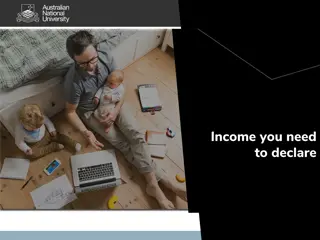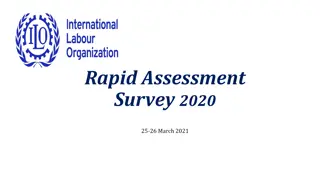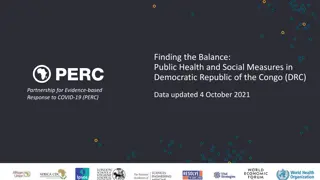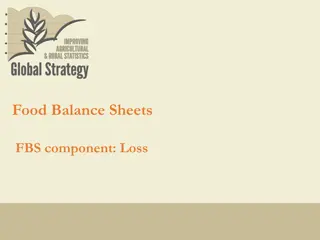Impact of COVID-19 on Income Loss and Food Security: Key Findings from a February 2021 Survey by PERC
The presentation highlights the impact of COVID-19 on income loss and food security, emphasizing the challenges faced by vulnerable populations. Key findings indicate pervasive income loss and barriers to accessing food, with social protection programs falling short in meeting needs. The report stresses the importance of targeted public health measures and improved social protection to mitigate the worsening economic and food security crises. Additionally, enhancing vaccine supply and access is crucial for both controlling the virus's spread and aiding economic recovery in Africa Union Member States.
Download Presentation

Please find below an Image/Link to download the presentation.
The content on the website is provided AS IS for your information and personal use only. It may not be sold, licensed, or shared on other websites without obtaining consent from the author.If you encounter any issues during the download, it is possible that the publisher has removed the file from their server.
You are allowed to download the files provided on this website for personal or commercial use, subject to the condition that they are used lawfully. All files are the property of their respective owners.
The content on the website is provided AS IS for your information and personal use only. It may not be sold, licensed, or shared on other websites without obtaining consent from the author.
E N D
Presentation Transcript
Partnership for Evidence-Based Response to COVID-19 Income loss and food security during the pandemic Key findings from a February 2021 survey from the Partnership for Evidence-Based Response to COVID-19 (PERC) 1 1 August, 2020
Table of contents Introduction About this presentation Key findings and recommendations In-depth findings Income loss and barriers to accessing food Focus on vulnerable populations Social protection programming Connection to health care access
About this presentation As Africa faces a third and possible fourth wave of new COVID- 19 infections amidst a backdrop of limited vaccine access, policymakers must seek to find a balance between implementing effective public health measures and the secondary impacts such measures can create. This presentation focuses specifically on how COVID-19 has affected income and food security since the start of the pandemic. The results and analysis are intended to support policymakers and advocates as they prepare to combat a prolonged pandemic into the second half of 2021 and beyond. The analysis is based primarily on the findings from PERC s most recent household surveys (from February 2021 with comparisons to results from August 2020) to understand how income and food access have changed over time. Additional information for some slides is included in the notes section. Further details on the survey and other in-depth analyses, such as the impact of the pandemic on access to essential health services, may be found at www.preventepidemics.org/perc. 19 AU Member States surveyed by PERC
Key findings: February 2021 PERC survey 1. Income loss and barriers to accessing food remain pervasive across all Member States surveyed and are getting worse. 2. Economic and food security burdens are being felt most severely by vulnerable populations who are already at high risk, especially those living in regions affected by conflict, natural disasters and rising food prices. 3. Social protection programs are not adequately meeting respondents needs and are not effectively targeting the most vulnerable populations. 4. Income loss is preventing people from accessing health services and likely contributing to increased mental health problems.
Call to Action With a third and possible fourth wave of new infections, driven by both new variants and limited vaccine access, public health and social measures (PHSMs) remain the best tool to limit the spread of COVID-19. To mitigate the economic and food security crises that such measures can exacerbate, however, governments and global actors must: Target PHSMs both geographically and to interventions with lower levels of secondary burden (such as mask-wearing, social distancing, and indoor capacity limits) to minimize the secondary economic impact. Prioritize investment in social protection programs where possible, and leverage successful examples from the pandemic (e.g., Ghana and Togo) to target benefits to those most in need. Increase vaccine supply and access to Africa Union Member States not only to stop the spread of COVID- 19, but also to enable economies to recover and begin reversing the economic and food security crises identified in this survey and elsewhere.
Income loss and barriers to accessing food remain pervasive and are getting worse.
The pandemic has caused widespread economic hardship; more than 60% of respondents from every Member State reported income loss Income loss since the start of the pandemic has been both broad and deep 77% reported losing income, including 15% who reported losing all income Income loss varied considerably by Member State, but was above 60% everywhere Highest in: Uganda (93%), Kenya (88%), Zambia (88%), Morocco (87%), Senegal (86%) Lowest in: Mozambique (61%), Ethiopia (65%), Egypt (66%), C te d Ivoire (69%) and South Africa (69%)
Most Member States that experienced high rates of income loss also implemented strict lockdowns Rates of income loss were highest in Uganda, reported by 93% of respondents, likely driven by strict PHSMs and enforcement. Uganda imposed among the strictest set of PHSMs of all Member States surveyed.1 PHSMs were strongly enforced by police, particularly ahead of the January election, which led to condemnation by UN Human Rights Council.2 Policymakers should consider limiting the extent of full-scale lockdowns and instead focus on more targeted interventions. Member State Income Loss (Rank)3 Peak Oxford Stringency Rating2 (Rank)3 Uganda 93% (1) 93 (2) Kenya 88% (2) 88.89 (4) Zambia 88% (3) 70.83 (19) Morocco 87% (4) 93.52 (1) 1 https://www.bsg.ox.ac.uk/research/research-projects/covid-19-government-response-tracker 2https://www.hrw.org/news/2021/01/21/uganda-elections-marred-violence 3 Among Member States included in the survey
15% of respondents reported losing all of their income since the start of the pandemic Member States in the Northern Africa Region had rates of complete income loss more than twice that of any other region. Member States particularly dependent on tourism have experienced some of the highest reported levels of complete income loss, such as Morocco (47%), Egypt (27%), Kenya (22%) and South Africa (17%). Percentage of households who reported having lost all of their income since the start of the pandemic 34% Northern Africa 15% Eastern Africa 12% Southern Africa 12% Central Africa 10% Western Africa
Although many Member States loosened PHSMs, income loss got worse in most Member States Percentage of households reporting loss of income across each Member State in February 2021 and change since August 2020 93% 88% 88% 87% 86% 80% 78% 78% 78% 77% 78% 76% 76% 73% 74% 69% 69% 66% 65% 61% 36% 28% 17% 13% 9% 7% 9% 7% 7% 7% 6% 6% -3% -4% -6% -6% 4% -7% -14% Feb-21 Change from August 2020 Note: in the August survey, respondents were asked to compare current income to the same time in the previous year. In February, respondents were asked to compare current income to before the pandemic. *No change recorded for Morocco because there was no survey fielded in August.
Barriers to food access were pervasive across the continent, but somewhat lower in Northern Africa than other regions More than 80% of respondents reported challenges accessing food in the past week. Highest rates of reported barriers to food access were in: Zambia (92%), Mozambique (92%), Sudan (92%), Liberia (92%), and Guinea (92%). Lowest rates of reported barriers to food access were in: Egypt (50%), Ghana (59%), C te d Ivoire (69%), Ethiopia (70%), and Morocco (72%). Percentage of households that reported experiencing at least one barrier to food access in the previous week in February 2021 88% Southern Africa 86% Central Africa 83% Eastern Africa 80% Western Africa 67% Northern Africa
Barriers to food access rose between August 2020 and February 2021, with the largest increases due to income loss and high food prices Percentage of respondents who reported each barrier to food access, August 2020 and February 2021 70% 65% 60% 55% 50% 45% 40% 35% 30% Aug-20 Feb-21 Price too high Shortages in the food markets Mobility restrictions imposed by the government Income dropped Markets closed
High food prices remain the largest barrier to food access, aligning with macroeconomic trends 65% of respondents listed high food prices as a barrier, up seven percentage points since August 2020. Rates of respondents listing food prices as a barrier were particularly concerning in Sudan (84%), Zambia (82%), Liberia (79%), Mozambique (79%), Kenya (77%), Guinea (77%) and DRC (71%). FAO Food Prince index in February was up 2.4% compared to January, despite favorable harvest seasons across much of Africa. Prices have continued upward throughout 2021 to date, due to inflation and economic decline, as well as natural and manmade disasters such as flooding, locust infestations and conflict. The United Nations and the World Food Programme have recently warned of significant increases in famine and malnutrition, listing 23 countries as high-risk hotspots for acute food insecurity, 16 of which are in Africa. Such conditions could further exacerbate COVID-19 transmission as people are forced to ignore safety protocols in order to find food to eat. FAO Food Price Index continues upward trajectory into 2021. Source: FAO Food Price Index Source: https://news.un.org/en/story/2021/03/1088022, https://docs.wfp.org/api/documents/WFP-0000125170/download/?_ga=2.268916725.547868199.1616512658- 940508497.1602276079
Nearly half of all respondents reported missing or delaying meals in the past week, including more than two-thirds of people in Kenya and Liberia Percentage of respondents who reported reducing the number of meals and/or the portion of each meal they would usually eat in the previous week 71% 68% 56% 55% 54% 54% 53% 52% 52% 50% 49% 49% 48% 48% 45% 40% 36% 29% 29% 28%
High prices and reduced income were the most common barriers to food access among households who reported missing or delaying meals in the previous week This finding highlights the role that the dual pressures of income loss and higher food prices are placing on households, causing nearly half of respondents to have to miss meals or reduce meal sizes.
Key Takeaways: Income loss was extremely high in February 2021 and had increased since August 2020. Member States dependent on tourism or those with stricter lockdowns were hit the hardest. Barriers to food access were extremely common and had worsened since August. PERC household-level data aligns with other sources that show increasing food prices across much of the continent as a result of inflation and economic decline, as well as natural and manmade disasters such as flooding, locust infestations and conflict.
Economic and food security burdens are being felt most severely by vulnerable populations who are already at high risk.
Low-income households are experiencing high levels of income loss and barriers to food access Percentage of households who had to skip or reduce the size of meals in the past week Percentage of households who reported losing some or all of their income since the start of the pandemic 81% 73% 56% 40% High Income Low Income High Income Low Income Income classifications were based on existing data on local income distributions, which were used to create three or four income bands depending on survey response frequencies. Data shown here are the highest and lowest categories.
Income loss is strongly associated with food insecurity, as nearly two-thirds of respondents who lost all their income reported missing or delaying meals. Percentage of respondents who reported missing or delaying a meal by levels of income loss 65% 51% 27% No income loss Lost all income Lost some income
Barriers to accessing food were much more common among those who had lost income, including less directly income-dependent barriers such as market closures and mobility restrictions Percentage of respondents who reported barriers to food access by levels of income loss 86% 70% 69% 60% 49% 45% 41% 41% 34% 30% 26% 26% Lost income (some or all) No income loss Any barrier Mobility Restrictions Market Closures Market Shortages High Prices Income Loss
Political and economic crises are causing direct economic hardship and driving increases in food insecurity at the household level The World Food Programme (WFP) recently released a major report highlighting 23 food security hotspot countries, 16 of which are in Africa, and seven of which were included in our survey. According to European Civil Protection and Humanitarian Aid Operations (ECHO) the number of children suffering from Severe Acute Malnutrition in the Sahel grew in 2020 from 2.4M to over 3M due to the pandemic, with conditions continuing to decline now well into 2021. DRC: WFP Findings: 19.6M people face acute food security threat (IPC/CH Phase 3 or higher), the highest number of food-insecure people in the world. This reflects a combination of conflict in the east, economic decline and socio-economic impacts of COVID-19. PERC Survey: 52% of respondents reported reduced meals; 78% reported loss of income, 35% of whom reported complete or large loss of income. Survey signaled major alarm and highlights food security risk across the nation. 19 AU Member States surveyed by PERC
Political and economic crises are causing direct economic hardship and driving increases in food insecurity at the household level Nigeria: WFP Findings: 13M people face acute food security threat, ranking fourth globally, driven by conflict in the northeast and economic downturn during the pandemic. PERC Survey: 55% of respondents reported missed meals; 78% reported loss of income. Ethiopia: WFP Findings:12.9M people face acute food security threat, ranking fifth globally, driven by conflict in Tigray, reduced rainfall and desert locust upsurge. PERC Survey: Respondents reported lower levels of food insecurity (29%) than elsewhere, suggesting survey coverage challenges in conflict-affected areas. Sudan: WFP Findings: 7.1M people face acute food security threat, driven by an economic crisis and security threats. PERC Survey: 84% of respondents reported high food prices as a barrier to food access; 74% reported loss of income. 19 AU Member States surveyed by PERC
Political and economic crises are causing direct economic hardship and driving increases in food insecurity at the household level Zimbabwe: WFP Findings: 3.4M people face acute food security threat, driven by weather shocks and macroeconomic instability. PERC Survey: 80% of respondents reported loss of income; over half (54%) had to reduce meals. Mozambique: WFP Findings:2.9M people face acute food security threat, driven by recent cyclones and conflict in the northern province of Cabo Delgado. PERC Survey: 79% of respondents reported high food prices as a barrier to food access; 54% had to reduce meals. Liberia: WFP Findings: 0.6M people face acute food security threat, driven by high food prices and low cereal production. PERC Survey: 71% of respondents had to reduce meals; 79% reported high food prices as a barrier to food access.. 19 AU Member States surveyed by PERC
Key Takeaways: Low-income households are experiencing especially high levels of income loss and food insecurity. Demographic factors unrelated to income level do not appear to drive differences in income loss or food access among surveyed households. Those who have lost some or all of their income are more likely to report missing or delaying meals in the past week, as well as experiencing barriers to food access. The economic and food security pressures of ongoing crises are apparent at the household level, such as conflict in DRC, Nigeria, Mozambique and Ethiopia, severe economic downturns in Nigeria, Sudan, DRC and Zimbabwe, and reduced agricultural production due to desert locusts and other natural disasters in Liberia, Ethiopia, Sudan and Mozambique.
Social protection programs are not adequately meeting respondents needs and are not effectively targeting the most vulnerable populations.
Overall, less than 15% of respondents reported receiving any government support Percentage of respondents reporting receiving any support from the government* in the past month All respondents 13% Ghana 44% Guinea 30% Uganda 27% Senegal 24% South Africa 22% Liberia 17% Ethiopia 10% DRC 10% Zimbabwe 6% Nigeria 6% Zambia 5% Cote d`Ivoire 5% Sudan 5% Morocco 4% Kenya 4% Tunisia 3% Cameroon 3% Mozambique 1% *That they did not receive before the COVID-19 pandemic
Cash transfers were the least common form of government support received Member State Cash Food Subsidy Personal Protective Equipment Any Government Support 1% 1% 0% 1% 3% Cameroon 1% 1% 1% 2% 5% C te d Ivoire 0% 1% 5% 3% 10% DRC 1% 6% 0% 4% 10% Ethiopia 3% 5% 44% Ghana 37% 12% 0% 2% 6% 30% Guinea 23% 2% 2% 0% 0% 4% Kenya 0% 0% 1% 17% Liberia 14% 4% 1% 0% 0% 4% Morocco 0% 0% 0% 0% 1% Mozambique 1% 4% 0% 0% 6% Nigeria 1% 3% 3% 24% Senegal 21% 1% 2% 22% South Africa 13% 11% 1% 1% 0% 2% 5% Sudan 3% 1% 0% 0% 3% Tunisia 0% 8% 0% 27% Uganda 22% 0% 1% 1% 3% 5% Zambia 2% 3% 0% 1% 6% Zimbabwe 2% 5% 4% 3% 13% Total
Targeting of relief programs appears mixed: low-income households were not more likely to receive benefits, but those that lost income were Low-income households were slightly less likely to receive support from the government than high-income households, suggesting that social protection programs are not effectively targeting the poor. However, those that reported losing income since the start of the pandemic were (in aggregate) 40% more likely to receive benefits, indicating that some programs are targeting those affected economically by the pandemic. Percentage of households reporting receiving government support they did not receive before the pandemic, by income loss and income level 13% 13% 11% 11% 9% Lost all income No income loss High Income Lost some income Low Income
There are positive examples across the continent of successful social protection programs during the pandemic that can be leveraged by those seeking to design new programs In Ghana, nearly half (44%) of all respondents reported receiving a benefit, primarily in the form of subsidized utilities a program the government launched early in the pandemic and extended in early 2021. An NBER working paper found that while this program missed the poorest households with limited access to utilities, it enabled immediate impact with broad reach without requiring new distribution infrastructure or beauracracy. South Africa also stands out for a series of generous social protection benefits it extended early in the pandemic and continued throughout. As the Member State hit hardest by the pandemic (at least in terms of known cases), these programs have proven essential to help buttress against the worst economic outcomes. In Ethiopia, only 10% of survey respondents reported receiving government support. However, a recent discussion paper suggests that for those who did receive support from the the Productive Safety Net Program (PSNP), it fully offset adverse economic impacts from the pandemic. Outside of PERC surveyed countries, Togo stands as an example of using novel technology to target social protection benefits. In response to COVID-19, the government partnered with researchers and international NGOs to develop the Novissi program, which uses satellite data on population density and mobile phone usage data to target cash transfers to the poor.
Key Takeaways: Respondents from most Member States reported very little government support beyond what they would have received before the pandemic, but the figures ranged considerably. When support has come, it has typically not been in the form of cash transfers; food, PPE or subsidized utilities were more common. Targeting of programs appears mixed: Low-income households were less likely to report receiving support than high-income households; however, those that lost income were more likely to get support than those with no income loss. There are a number of successful programs that were launched across the continent that can serve as positive examples for others seeking to expand their safety net programming.
Income loss is preventing people from accessing health services and likely contributing to increased mental health problems.
Affordability was a leading cause of missed health care visits Percentage of respondents who missed health care visit attributing it to cost/affordability of health care All respondents 20% Cameroon 36% Cote d`Ivoire 30% Uganda 30% Morocco 29% Kenya 28% Liberia 25% Nigeria 24% Guinea 21% Tunisia 18% Sudan 18% DRC 18% Senegal 15% South Africa 15% Zimbabwe 13% Ghana 10% Zambia 8% Mozambique 8% Egypt 8% Ethiopia 4%
Health care affordability affected those who had lost income significantly more than those who had not Percentage of respondents attributing missed care to cost/affordability issues by loss of income during the pandemic 30% 18% 13% Lost some income No income loss Lost all income
Household income and degree of income loss were also associated with difficulty accessing medication Issues accessing medication were highest among the lowest income respondents, as well as those that lost some or all of their income during the pandemic. Percentage of households in need of medication that reported it was much more or a bit more difficult to access it in previous three months 60% 51% 47% 47% 50% 38% 40% 27% 30% 20% 10% 0% High income Lost all income Lost some income No income loss Low income
Secondary burdens of income loss and food insecurity are taking a toll on the mental health of those already suffering these material losses Percentage of individual respondents experiencing symptoms of anxiety or depression, by income loss, missed meals, and barriers to food access 21% 18% 14% 8% 3% 2% Lost Income Missed meals Any barrier to food access Did not lose income Did not miss meals No barriers to food access
Key Takeaways: Affordability was a leading cause of missed health care visits, which was especially pronounced among those who have lost income since the start of the pandemic. Household income and degree of income loss also appear to be driving people s difficulty accessing medication. Mental health symptoms were much more pronounced among individuals living in households that have lost income, missed meals and faced barriers to food access.























